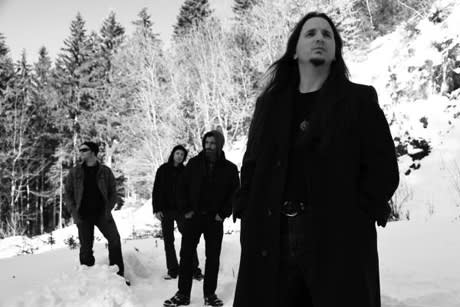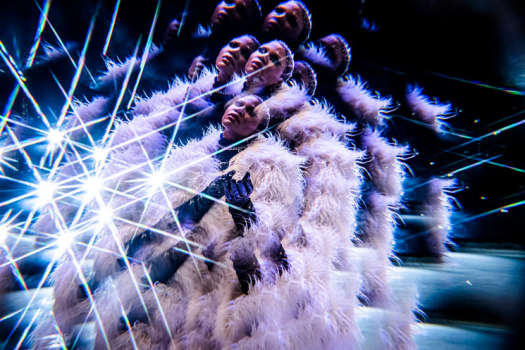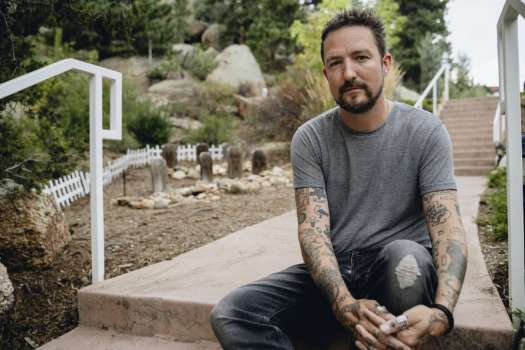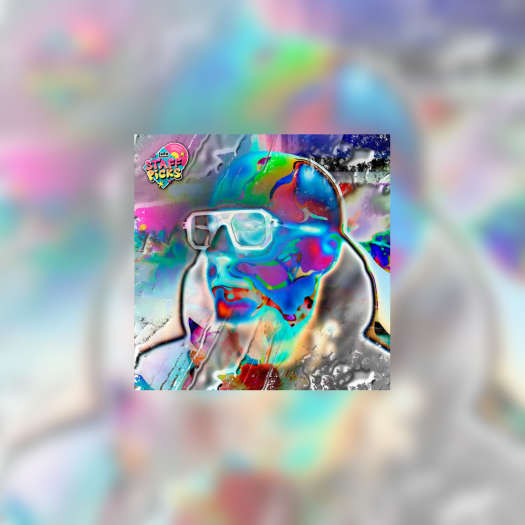At a superficial glance, Agalloch, from Portland, Oregon, appear to be one of the U.S.'s most intriguing extreme metal bands. This is a powerful first impression, but there's much more to the music Agalloch write and perform than a simple genre label can describe. From their early albums Pale Folklore (1999) and The Mantle (2002) to their most recent White EP (2008), the band have progressed through a multidimensional exploration of black metal, neo-folk, doom and progressive rock, among other sounds. This year's Marrow of the Spirit (on Profound Lore in North America) continues in the same vein but reveals Agalloch at a new stage of evolution, extending their range even further along little charted sonic terrain. Agalloch's vocalist and guitarist Jon Haughm answers some questions about the process and result that is the band's newest record.
Agalloch fans haven't exactly been starved for material since the release of Ashes Against the Grain in 2006 but four years is still a fairly long space between full-length albums. Why the wait for Marrow of the Spirit?
We typically don't work on a follow-up album immediately after the current one. We didn't even begin writing Marrow of the Spirit until the summer of 2008 so I don't understand what the big deal is. We put out a record when we feel like it, when the record is ready. Whether that is in four years or ten years, it doesn't matter to us.
The bird song, running water, insect sounds, lyrics that mention woods... None of these things seems out of place on an Agalloch record, but they all contribute to a particular atmosphere weaving throughout Marrow of the Spirit. How does nature figure into this album specifically?
These elements make up the microcosm in which this album exists. This is not some prosaic folk metal record, mind you. We are more interested in the world within the cells of the plants, in the souls of the birds, the dichotomy between the world that exists to the modern living and the world that exists within the perspective of an ancient ghost, etc...
How would you describe the album's atmosphere? What role did production and your use of analog technologies and vintage equipment have in shaping the record's atmospheric quality?
We wanted an album that sounded more alive and real. So many metal albums sound like they were created by machines — much of which is true. Our last album was a bit too mechanized, too polished, and that kind of disturbed us. So we brought back the older methods that we had utilized on our demos and first album to try and get back a more organic feeling. I think this attitude and this album has laid a new foundation for us to expand upon and for once I am actually quite excited to get started on our next album.
The songwriting and performance also feeds into that sonic imagery, almost as if you're replicating natural textures and rhythms through your music. How do you hear that relationship between, say, song structure and performance style and the images, feelings and surfaces they evoke?
When we were tracking guitars, there was a part where Don [Anderson] and I were off a bit with our accents. We weren't off time, we just accented at different points. I figured maybe we should try another take but Steven [Wray Lobdell] suggested otherwise because it simply sounded like two guitarists playing live. I think the result of the whole record has this vibe, which is cool. The record is more an organic living being instead of a bunch of digital instrument tracks put together, lined up to a grid, and edited to death. I think production is one reason I have a difficult time listening to a lot of modern metal albums. They sound so fucking dull to me.
How much impact did each of you have on how the album came together? With new drummer Aesop Dekker joining for this recording, what effect did his involvement have on the record's flow and momentum?
I always lay the foundation for the material; the initial song structures, the aesthetic and atmospheric goals. The other guys add their input to what I start. One exception being that Don and Jackie [Perez Gratz, guest cellist] created the "bookend" tracks but I certainly directed the result along the way. Aesop added a nice looseness to the album's flow and rhythm.
Parts played by those outside the band seem very noteworthy here as well. Why these particular guests? Did they devise their own contributions or did you have very specific things in mind when you recruited them to participate? How did that process unfold?
Jackie Perez Gratz is an old friend. We have played with her other bands [Grayceon, Giant Squid, Asunder, Amber Asylum] and Don has kept in contact with her. We wanted some cello on the album so he called her up and she was quite excited to contribute.
Jeffrey Neblock is from an ambient/dark metal band called Vindensång. I met him last year and we became very good friends almost instantly. We both have very similar tastes in music and aesthetics. He has visited a couple times and, while at my house, he was playing my old piano. I basically said to him "you should play that on the next Agalloch album" and he was very into the idea. He actually recorded a full six-minute piano piece that we extracted from for the album. The full version will be on a seven-inch that will come with a special edition of the album.
Our photographer Veleda Thorsson provided sheet metal scratches, broken glass, and petrified bones to a couple of the songs. Nate Carson, our booking agent in the U.S. and drummer of the band Witch Mountain, has a pretty cool collection of old Moog synths. I wanted to have a section on the album where everything would fall into a spacey drone as I am a big fan of old Tangerine Dream and various other German kosmische artists so he was quite into the idea of playing his old synths on the new album.
Despite the vastly different (if melodically complementary) sounds of its opening and closing moments, Marrow of the Spirit seems to hint at a cyclical, or perhaps spiral, development. How do you see the relationship between the individual songs on the record? Or the relationship of each song to the album's whole?
The album is a journey. A full day, night, and new day unfold during the 65 minutes of this album. Each song is a different stop, a unique destination along the way from the river, through the forest, to the sea. But there is more. Like I said before, many of the concepts on this record exist within parallel universes. For instance, the story of "Into The Painted Grey" could easily take place within the "universe" of a microscopic cell in a drop of water.
You've mentioned cinematic inspirations for Marrow of the Spirit. How did the work of Hungarian filmmaker Bela Tarr influence this album? What qualities or elements of a film tend to inspire you musically?
A film is a fully encompassing experience — it is visual, aural, emotional. We try to accomplish the same kind of experience that one would find in a good film, but within the relatively limiting space of the album format. This is of course a lofty goal but I think we have accomplished it at least some of the time. Bela Tarr is one of many, many filmmakers I admire. His eight-hour epic Santantago is a misery in itself that everyone should experience. Absolutely crushing cinema. The Czech filmmakers Jiri Barta and Frantisek Vlacil are two others who left their mark on me during the making of Marrow Of The Spirit.
Agalloch fans haven't exactly been starved for material since the release of Ashes Against the Grain in 2006 but four years is still a fairly long space between full-length albums. Why the wait for Marrow of the Spirit?
We typically don't work on a follow-up album immediately after the current one. We didn't even begin writing Marrow of the Spirit until the summer of 2008 so I don't understand what the big deal is. We put out a record when we feel like it, when the record is ready. Whether that is in four years or ten years, it doesn't matter to us.
The bird song, running water, insect sounds, lyrics that mention woods... None of these things seems out of place on an Agalloch record, but they all contribute to a particular atmosphere weaving throughout Marrow of the Spirit. How does nature figure into this album specifically?
These elements make up the microcosm in which this album exists. This is not some prosaic folk metal record, mind you. We are more interested in the world within the cells of the plants, in the souls of the birds, the dichotomy between the world that exists to the modern living and the world that exists within the perspective of an ancient ghost, etc...
How would you describe the album's atmosphere? What role did production and your use of analog technologies and vintage equipment have in shaping the record's atmospheric quality?
We wanted an album that sounded more alive and real. So many metal albums sound like they were created by machines — much of which is true. Our last album was a bit too mechanized, too polished, and that kind of disturbed us. So we brought back the older methods that we had utilized on our demos and first album to try and get back a more organic feeling. I think this attitude and this album has laid a new foundation for us to expand upon and for once I am actually quite excited to get started on our next album.
The songwriting and performance also feeds into that sonic imagery, almost as if you're replicating natural textures and rhythms through your music. How do you hear that relationship between, say, song structure and performance style and the images, feelings and surfaces they evoke?
When we were tracking guitars, there was a part where Don [Anderson] and I were off a bit with our accents. We weren't off time, we just accented at different points. I figured maybe we should try another take but Steven [Wray Lobdell] suggested otherwise because it simply sounded like two guitarists playing live. I think the result of the whole record has this vibe, which is cool. The record is more an organic living being instead of a bunch of digital instrument tracks put together, lined up to a grid, and edited to death. I think production is one reason I have a difficult time listening to a lot of modern metal albums. They sound so fucking dull to me.
How much impact did each of you have on how the album came together? With new drummer Aesop Dekker joining for this recording, what effect did his involvement have on the record's flow and momentum?
I always lay the foundation for the material; the initial song structures, the aesthetic and atmospheric goals. The other guys add their input to what I start. One exception being that Don and Jackie [Perez Gratz, guest cellist] created the "bookend" tracks but I certainly directed the result along the way. Aesop added a nice looseness to the album's flow and rhythm.
Parts played by those outside the band seem very noteworthy here as well. Why these particular guests? Did they devise their own contributions or did you have very specific things in mind when you recruited them to participate? How did that process unfold?
Jackie Perez Gratz is an old friend. We have played with her other bands [Grayceon, Giant Squid, Asunder, Amber Asylum] and Don has kept in contact with her. We wanted some cello on the album so he called her up and she was quite excited to contribute.
Jeffrey Neblock is from an ambient/dark metal band called Vindensång. I met him last year and we became very good friends almost instantly. We both have very similar tastes in music and aesthetics. He has visited a couple times and, while at my house, he was playing my old piano. I basically said to him "you should play that on the next Agalloch album" and he was very into the idea. He actually recorded a full six-minute piano piece that we extracted from for the album. The full version will be on a seven-inch that will come with a special edition of the album.
Our photographer Veleda Thorsson provided sheet metal scratches, broken glass, and petrified bones to a couple of the songs. Nate Carson, our booking agent in the U.S. and drummer of the band Witch Mountain, has a pretty cool collection of old Moog synths. I wanted to have a section on the album where everything would fall into a spacey drone as I am a big fan of old Tangerine Dream and various other German kosmische artists so he was quite into the idea of playing his old synths on the new album.
Despite the vastly different (if melodically complementary) sounds of its opening and closing moments, Marrow of the Spirit seems to hint at a cyclical, or perhaps spiral, development. How do you see the relationship between the individual songs on the record? Or the relationship of each song to the album's whole?
The album is a journey. A full day, night, and new day unfold during the 65 minutes of this album. Each song is a different stop, a unique destination along the way from the river, through the forest, to the sea. But there is more. Like I said before, many of the concepts on this record exist within parallel universes. For instance, the story of "Into The Painted Grey" could easily take place within the "universe" of a microscopic cell in a drop of water.
You've mentioned cinematic inspirations for Marrow of the Spirit. How did the work of Hungarian filmmaker Bela Tarr influence this album? What qualities or elements of a film tend to inspire you musically?
A film is a fully encompassing experience — it is visual, aural, emotional. We try to accomplish the same kind of experience that one would find in a good film, but within the relatively limiting space of the album format. This is of course a lofty goal but I think we have accomplished it at least some of the time. Bela Tarr is one of many, many filmmakers I admire. His eight-hour epic Santantago is a misery in itself that everyone should experience. Absolutely crushing cinema. The Czech filmmakers Jiri Barta and Frantisek Vlacil are two others who left their mark on me during the making of Marrow Of The Spirit.




